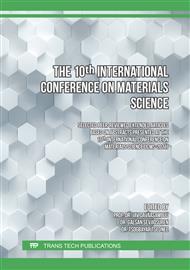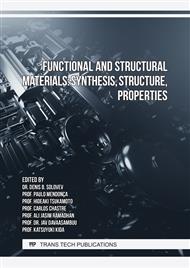[1]
M. Sabbouh, A. Nikitina, E. Rogacheva, L. Kraeva, S. Ulasevich, E. Skorb and M. Nosonovsky, Separation of motions and vibrational separation of fractions for biocide brass, Ultrasonics Sonochemistry 80 (2021) 105817.
DOI: 10.1016/j.ultsonch.2021.105817
Google Scholar
[2]
A.S. Lozhkomoev, O.V. Bakina, A.V. Pervikov, S.O. Kazantsev and E.A. Glazkova, Synthesis of CuO–ZnO composite nanoparticles by electrical explosion of wires and their antibacterial activities, Journal of Materials Science, Materials in Electronics, 30 № 14. (2019) 13209–13216.
DOI: 10.1007/s10854-019-01684-4
Google Scholar
[3]
P. V. Kazakevich, V. V. Voronov, A. V. Simakin and G. A. Shafeev, Formation of copper and brass nanoparticles during laser ablation in a liquid, Quantum Electron., 34:10 (2004) 951–956.
DOI: 10.1070/qe2004v034n10abeh002756
Google Scholar
[4]
S.P. Bardakhanov, A.I. Korchagin, N.K. Kuksanov, A.V. Lavrukhin, R.A. Salimov, S.N. Fadeev and V.V. Cherepkov, Obtaining nanopowders by evaporation of initial substances in an electron accelerator at atmospheric pressure, Reports of the Academy of Sciences 409, №3 (2006) 320–323.
DOI: 10.1134/s1028335806070044
Google Scholar
[5]
N.V. Yumozhapova, A.V. Nomoev, V.V. Syzrantsev and E.Ch. Khartaeva, Formation of metal/semiconductor Cu-Si composite nanostructures, Beilstein Journal of Nanotechnology, 10 (2019) 2497–2504.
DOI: 10.3762/bjnano.10.240
Google Scholar
[6]
A.V. Nomoev, S.P. Bardakhanov, M. Schreiber, D.Z. Bazarova, B.B. Baldanov and N.A. Romanov, Synthesis, characterization, and mechanism of formation of janus-like nanoparticles of tantalum silicide-silicon (TaSi2/Si), Nanomaterials. 5. № 1 (2015) 26-35.
DOI: 10.3390/nano5010026
Google Scholar
[7]
A.V. Nomoev, N.T. Torhov, E.Ch. Khartaeva, V.V. Syzranthev, N.V. Yumozhapova, M.A. Tsyrenova and V.N. Mankhirov, Special aspects of the thermodynamics of formation and polarization of Ag/Si nanoparticles, Chemical Physics Letters, 720 (2019) 113-118.
DOI: 10.1016/j.cplett.2019.02.015
Google Scholar
[8]
A.V. Nomoev, E.Ch. Khartaeva, N.V. Yumozhapova, T.G. Darmaev, S.P. Bardakhanov, V.V. Syzranthev, K.V. Zobov, and Y.Y. Gafner, Receiving copper nanoparticles: experiment and modelling, Solid State Phenomena, 288 (2019) 140–147.
DOI: 10.4028/www.scientific.net/ssp.288.140
Google Scholar
[9]
State Standard 15527-2004. Pressure treated copper zinc alloys (brasses). Grades. Moscow, Standartinform Publ., 2005 (In Russian).
Google Scholar
[10]
O.A. Bannykh, P.B. Budberg, S.P. Alisova et al. State diagrams of binary and multicomponent systems based on iron. Metallurgy, (1986)
Google Scholar
[11]
S.V. Shukhardina, Binary and multicomponent systems based on copper. Science, 1979.
Google Scholar
[12]
N.P. Lyakisheva, Phase diagrams of binary metallic systems, Mechanical engineering, 1996-2000.
Google Scholar
[13]
https://doncarb.com/articles/grafitovyy-tigel/
Google Scholar
[14]
A.P. Zavjalov, K.V. Zobov, V.V. Syzrantsev and S.P. Bardakhanov, Full surface concept in the preparation and application of silicon dioxide nanopowder, Vestn. NSU Series: Physics, 9:4 (2014) 80–88.
DOI: 10.54362/1818-7919-2014-9-4-80-88
Google Scholar
[15]
K. Ellmer, D.S. Ginley, H. Hosono and D.C. Paine, Transparent Conductive Zinc Oxide and Its Derivatives, in: Handbook of transparent conductors, Springer (2010) 193-263.
DOI: 10.1007/978-1-4419-1638-9_7
Google Scholar
[16]
T. Yamashita, R. Hansson and P.C. Hayes, The relationships between microstructure and crystal structure in zincite solid solutions, J. Mater. Sci. 41 (2006) 5559-5568.
DOI: 10.1007/s10853-006-0343-x
Google Scholar
[17]
G. Lee, T. Kawazoe and M. Ohtsu, Room Temperature Near-Field Photoluminescence of Zinc-Blend and Wurtzite ZnO Structures, Applied surface science 239, 3 (2005) 394-397.
DOI: 10.1016/j.apsusc.2004.06.004
Google Scholar
[18]
N.A. Vatolin, G.K. Moiseev and B.G. Trusov, Thermodynamic modeling in high-temperature inorganic systems, Metallurgy (1994) 352.
Google Scholar
[19]
B.G. Trusov, Software package TERRA for the calculation of plasma-chemical processes, Materials of the III Intern. symp. on theoretical and applied plasma chemistry, Ples, (2002) 217-218.
Google Scholar



